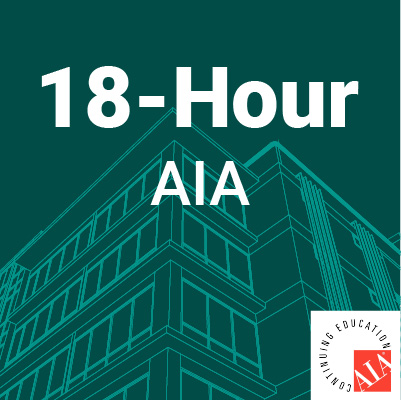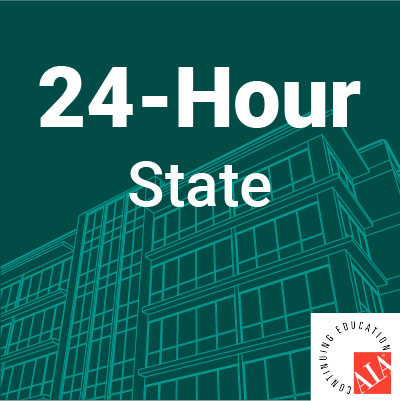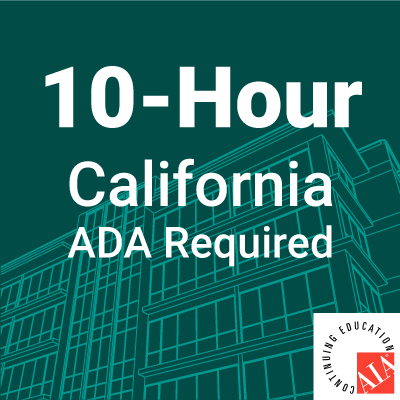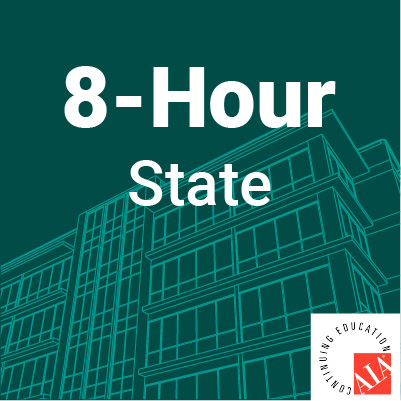Description
This 18-hour package contains:
Course #1 – (5 hour Audio Course) Moving Toward Net Zero | #AIABLTI518 CA Net Zero Carbon Design Course
Course #2 – (5 hour Audio Course) CA Building Code Division 2: Accessibility | #AIABLTI331.23 CA ADA Course
Course #3 – (4 hour Audio Course) Designing Worship Facilities | #AIABLTI515.22
Course #4 – (4 hour Audio Course) Acoustical Design In Modern Architecture | #AIABLTI342.23
Moving Toward Net Zero
Instructor: Paul Spite
Sustainability is defined by one source as “meeting current needs, without compromising the ability of future generations to meet their needs, in the environment we will leave them.” Net zero refers to achieving an overall balance between carbon-based emissions produced and the removal or offsetting of the same amount of carbon from the atmosphere. Taken together, striving to meet these two objectives can result in choices made in project design and project use, resulting in the least harm possible being done to our environment.
We will examine a few key principles involved in moving toward ‘net zero:
- Designing buildings that use as little energy as possible, once occupied as intended
- Generating as much power on-site, or the equivalent thereof, to supply the power still needed and used by the facility
- Look at carbon emissions and ways to lower or offset greenhouse gas emissions as a result of our activities
This course teaches the following knowledge and skills:
- An understanding of what is being referred to, when ‘net zero’ is being discussed
- An overview of broad strategies used in designing sustainable buildings
- Identifying sources of more environmentally friendly materials for incorporation in projects
- Why buildings renovated for adaptive reuse are arguably the greenest buildings.
- How incorporating passive design principles can reduce future energy use.
- Use of the earth’s temperature below the frost line to preheat and precool incoming air
- A good understanding of different options for insulating building envelopes
- How LEED certification can be sought and obtained
- Different ways in which green power can be purchased
- Criteria that can be used in purchasing Renewable Energy Certificates
- The various technologies used to generate power on site from renewable resources
- Steps to be taken in planning for an on-site renewable generation project
- The primary differences between renewable energy certificates and carbon offsets
- How clean water state revolving funds are used to finance conservation projects
This Course Covers:
Overall Steps in Reaching Net Zero
Part One – Minimizing Energy Use in Buildings
- Broad Design Concepts for Energy Conservation
- Energy Audits
- Passive Site and Building Design
- Designing for LEED Certification
- Recycling Buildings
- Energy Efficient Building Envelopes
- Energy Efficient Building Components
- Lifestyle Choices to Conserve Energy and Other Resources
- Creating Replacement Power
- Summary of Minimizing Energy Use
Part Two – Minimizing Carbon Output
- Purchasing Green Power
- Purchasing Carbon Offsets
- Funding Land Conservation Projects with the Clean Water State Revolving Fund
- Summary of Reducing Carbon Output
California Required Building Code: Division 2: Accessibility
Instructor: Rodger B. Peck
(If you are being audited by the Board, please print out this section It contains the information needed for the continuing education audit.)
Rodger has over 25 years experience building, teaching and consulting with individuals in the construction industry. He has conducted extensive research and study in developing, compiling and writing Americans with Disabilities Act courses for architects, engineers, and commercial and residential builders. Rodger holds a vast amount of certifications and approvals, both State specific and nationally:
- Michigan Residential Builders License #2101137251
- American Institute of Architect (AIA) approved instructor
- International Distance Education Certified (IDECC) Qualified #67861
- Lead Paint Safety (RRP) Certified Instructor through the Environmental Protection Agency (EPA)
- Alabama Licensing Board approved instructor
- Florida Department of Business and Professional Regulation (DBPR) approved instructor
- Georgia Board for Residential and General Contractors (BRGC) approved instructor
- Massachusetts Department of Public Safety (DPS) approved instructor
- Michigan Licensing and Regulatory Affairs (LARA) approved instructor
- Minnesota Department of Licensing and Industry (DLI) approved instructor
- Oregon Construction Contractor Board (CCB) approved instructor
- Utah Department of Occupational and Professional Licensing (DOPL) approved instructor
- Virginia Department of Professional and Occupational Regulation (DPOR) approved instructor
The ADA is one of America’s most comprehensive pieces of civil rights legislation that prohibits discrimination and guarantees that people with disabilities have the same opportunities as everyone else to participate in the mainstream of American life — to enjoy employment opportunities, to purchase goods and services, and to participate in State and local government programs and services. The standards set minimum requirements – both scoping and technical – for newly designed and constructed, or altered state and local government facilities, public accommodations, and commercial facilities to be readily accessible to and usable by individuals with disabilities.
This five hour audio course covers the second chapter of the ADA Standards for Accessible Design and includes the California modifications found in Division 2, Chapter 11B of the California Building Code including the most recent changes. While an individual designer may be able to use the ADA for personal or generic residential design, the California code should be used by registered design professionals and enforcement officials and applied when the project is for public use within the state of California.
After completing this course, participants will be able to:
- Recognize how the overall philosophy of the Americans with Disabilities Act can, and does create an environment of opportunity and non-discrimination.
- Be able recognize what facilities can, and should comply with Chapter 11B Accessibility of the California Building Code.
- Outline at least one design strategy based on accessibility standards for the construction of either a public or private building.
- Summarize the options available to the design or building professional when designing a facility per the requirements of Chapter 11B.
This Course Covers:
- Application
- Existing Buildings and Facilities
- General Exceptions
- Protruding Objects
- Operable Parts
- Accessible Routes: Work areas, Amusement parks, Recreational areas, Entrances, Lifts
- Accessible Means of Egress
- Parking Spaces
- Passenger Loading Zones and Bus Stops
- Stairways
- Drinking Fountains
- Kitchens, Kitchenettes, and Sinks
- Toilet Facilities and Bathing Facilities
- Washing Machines and Clothes Dryers
- Fire Alarm Systems
- Signs
- Telephones
- Transportation Facilities
- Assistive Listening Systems
- Automatic Teller Machines and Fare Machines
- Assembly Areas
- Dressing, Fitting, and Locker Rooms
- Medical Care and Long-term Care Facilities
- Transient Lodging Guest Rooms
- Storage
- Dining Surfaces and Work Surfaces
- Sales and Service
- Depositories, Vending Machines, Change Machines, Mail Boxes and Fuel Dispensers
- Windows
- Two-Way Communication Systems
- Judicial Facilities
- Detention Facilities and Correctional Facilities
- Residential Facilities
- Recreational Boating and Golf Facilities
- Exercise Machines and Equipment
- Play Areas
- Saunas and Steam Rooms
- Swimming Pools, Wading Pools and Spas
- Shooting Facilities with Firing Positions
Designing Worship Facilities
Instructor: Paul Spite
Many decisions need to be made when undertaking the design of a facility to be used for worship. Some are esoteric, dealing with considerations on how to design the structure to best approach God. But others are more mundane, concerned with the fact that before the building may be occupied, the designer must first please men. This course will deal with the second.
Satisfying the needs of people involved in the project will involve those both inside and outside of the client group. Unless societal guidelines, like codes, zoning restrictions and existing easements are honored, regulatory agencies can make sure the building process doesn’t begin. Lending agencies will impose restrictions that must be honored. Site conditions will result in sometimes inflexible conditions on how the land may be used. The needs of the building community that will be translating construction documents into a physical reality must be addressed, as well as the way that process will come to fruition. Finally, every member of the religious group called the client will be bringing their own ideas to the table regarding the desired end result.
This course is designed to look at the many, sometimes seemingly endless parameters and decisions that must be made and addressed, before and during the design of a worship facility.
This course teaches the following specific knowledge and skills.
- A thorough understanding of the types of parameters that must be satisfied in the design of worship facilities
- An increased awareness of the various functions usually needing accommodated in worship facilities
- Knowledge of basic options available to religious groups facing the need to change or expand their facilities to accommodate growth
- How to guide religious groups in acknowledging the many costs besides the building, involved in completing projects, considering sources for capital and determining their financial feasibility of proceeding
- Educating clients regarding various players who will be involved in making their dream a reality and how to go about selecting them
- Different societal guidelines that act as parameters to be met while designing worship facilities
- Master planning considerations that should be incorporated in sites, buildings, systems and furnishings for religious clients
- Basic acoustic considerations to be addressed while designing the primary spaces of buildings used for assembly purposes
- Practical considerations and rules of thumb that help with initial layouts and schematic design of worship facilities
- Typical areas of concern found in building code restrictions, tending to govern the design of worship facilities.
This course covers:
- Introduction
- Options for Growth
- Counting the Costs
- Potential Sources of Capital
- Players in the Process
- Master Planning
- Acoustics in Worship
- Practical Concerns / Rules of Thumb
- Materials and Choices
- Rules and Regulations
- Building Codes Pertinent to Worship Facilities
- Conclusion
Acoustical Design In Modern Architecture
Course Instructor: Paul Spite
Unwanted sound impacts and affects inhabitants of our created spaces. If it not already, controlling noise will quickly become a mandated concern for designers. Attesting to increasing regulatory focus on noise, there is a recent proliferation of standards, guidelines, and codes regarding acoustics.
Very soon, many of these guidelines will no longer be mere suggestions. Most concerns covered in these standards can be addressed with a basic understanding on how sound travels and is reflected, blocked, absorbed, or transmitted by materials and assemblies chosen in designing envelopes.
Acoustic design is best addressed in an incremental fashion. This course was written to do just that. Fundamentals are first covered, including basic principles regarding sound, how its energy moves through matter, how its path and intensity can be altered, and how success in the manipulation of sound is measured. Known design strategies are discussed for controlling sound moving; from exterior to interior spaces, from interior spaces to adjacent spaces, within interior spaces, through structural components, and through building systems. Design considerations are outlined for numerous common building functions. Finally, acoustic codes and guidelines in existence now, are listed for consideration.
After completing this course participants will be able to:
- Design objectives and recommended best practices for building types where poor acoustics directly impact productivity and health of the users.
- Determine sources of noise that negatively impact users of built environments, generated both outside and from within buildings, including both air borne and structure borne sounds.
- Outline basic design practices for effectively controlling; sound transfer between exterior and interior spaces, noise transfer from interior space to adjacent spaces, and the reverberation of sound generated within spaces.
- Provide an overview of regulations and guidelines that either are, or may become law underscoring a need for competency in acoustic design, before legislatures make designing for noise control mandatory.
This Course Covers:
- Acoustics in General
- General Vocabulary Regarding Sound and Nature of Sound
- Production, Control, sound transmission and Reception
- Audible Sound Frequencies
- Effects of Sound on People
- Principals of Acoustics
- Sound Behavior Patterns
- Acoustic Measurements
- Amplified Sound
- Design Solutions for Specific Concerns Regardles of Project Type
- Resisting transmission of noise from the exterior into the interior of a space
- Resisting horizontal and vertical transmission of noise from space to adjacent space, including structure borne sound
- Controlling reverberation time of sound generated within a space
- Masking unwanted noise with sound generating systems
- Controlling system sounds, especially HVAC noises, that enter a space
- Design Considerations by Specific Project Type
Credit(s) earned on completion of this course will be reported to AIA CES for AIA members. Certificates of Completion for both AIA members and non-AIA members are available to print upon completion of the course.
This course is registered with AIA CES for continuing professional education. As such, it does not include content that may be deemed or construed to be an approval or endorsement by the AIA or any material of construction or any method or manner of handling, using, distributing, or dealing in any material or product.



